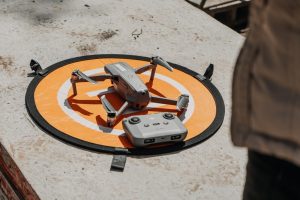The use of drones in the energy sector is transforming the way critical infrastructure such as solar farms,wind farms and transmission towers are inspected and maintained.
Not only do they improve efficiency, but their use also reduces costs and increases asset safety.
At Grupo UAS we offer specialized solutions for the inspection of critical infrastructures with drones. Find out how we can help you.
Why Use Drones in the Energy Sector?
Currently, the energy sector is facing challenges related to safety, costs and efficiency in infrastructure management. In this context, drones provide effective solutions to combat these challenges.
The use of drones allows you to perform scheduled flights over large areas of land and easily access high or difficult to reach areas, without disrupting the normal operation of the facilities.
Thanks to their built-in thermal cameras and high-precision sensors, they can detect faults, cracks, hot spots, structural damage or damage to electrical components.
The energy sector requires a high standard of reliability and continuity, which is why drones have become an ideal tool for maintaining infrastructures in optimal conditions and anticipating possible failures or problems.
Benefits of Drone Use in the Energy Sector
- Increased safety for personnel: Using drones eliminates the need for technicians to directly access hazardous environments such as high voltage areas, elevated structures. This reduces the risk of occupational accidents at the facility.
- Reduced operating costs: Thanks to these tools, inspections are carried out quickly and efficiently, minimizing the use of logistical resources, travel, lifting equipment and manpower.
- More accurate and detailed data: High-resolution images and advanced sensors facilitate the early detection of faults or irregularities. This results in more effective preventive maintenance.
- Time savings: The traditional way of carrying out inspections requires more time, while with the use of drones they are carried out in less time. As a consequence, the downtime of the asset is reduced, thus improving its productivity.
- Sustainability and lower environmental impact: The inspection process decreases its environmental impact by reducing the need for heavy machinery or invasive interventions. Drones have a minimal environmental footprint, so their use contributes to a more sustainable management of infrastructures by reducing emissions.
Drone Applications in the Inspection of Energy Infrastructures
1. Inspection of Power Towers and Transmission Lines
Power towers and power lines are critical infrastructures and difficult to inspect, as they are high voltage areas. They rely on drones equipped with high-resolution cameras and thermal sensors to detect problems such as cable faults or hot spots quickly and accurately. This reduces the risk of manual labor and improves safety.
2. Inspection of Solar Plants and Wind Farms
The use of drones equipped with multispectral sensors can identify damaged, dirty or inefficient panels in solar plant installations.
Similarly, in wind farms they can perform inspections of wind turbine blades, detecting cracks or wear in the structures.
3. Oil Infrastructure Monitoring
In the oil and gas sector, drones are a key tool for inspecting offshore platforms or onshore facilities. They can identify gas leaks, corrosion or structural damage, preventing catastrophic failures and improving operational safety.
Predictive Maintenance with Drones
Predictive maintenance is one of the biggest advantages offered by drones in the energy sector. With the use of LiDAR sensors, thermal sensors and high-resolution cameras, drones can identify early signs of failures before they occur.
This approach not only helps prevent costly breakdowns, but also optimizes the lifetime of energy assets and reduces facility downtime.
Implementing predictive maintenance with drones will allow you to save costs in the long run and improve the reliability of your energy infrastructure.
Conclusion
Drones are changing the way companies in the energy sector manage their critical infrastructure. With benefits such as reduced costs, improved safety and greater efficiency, drones are becoming an essential tool for inspecting and maintaining solar plants, wind farms and transmission towers.
If your company has not yet adopted this technology, it’s time to consider how drones can optimize your energy facilities.



